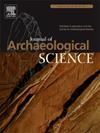庞培城的颜料。一瞥古罗马的着色材料
IF 2.6
1区 地球科学
Q1 ANTHROPOLOGY
引用次数: 0
摘要
颜料发挥了至关重要的技术作用,使先进的艺术技术得以发展,通过壁画等耐用材料保护文化遗产,促进了早期化学的创新,如合成着色化合物的创造。本文研究了在公元前3世纪到公元79年庞贝火山爆发期间的一些特殊背景中发现的颜料,几乎涵盖了古代画家的整个调色板,包括天然和合成,无机和有机颜料。为了保存这些宝贵的考古资源,我们采用了一种非侵入性的分析方法,从而揭示了它们的组成,这表明艺术家们巧妙地混合了色彩材料,以达到数不清的色调范围。量化任何一种着色化合物都可以回顾古代文献和现代科学文献中报道的配方,并为可能始于色素室的艺术过程开辟新的场景。在对混合物的分析中,埃及蓝铅和红铅在色调变化中的作用值得注意,它们作为油漆混合物中几乎无处不在的附加成分,值得注意。最终,其中一个样本揭示了已知最早使用的一种含有重晶石和明矾石的浅绿色化合物,为古代地中海地区使用硫酸钡提供了第一个明确的证据。本文章由计算机程序翻译,如有差异,请以英文原文为准。
Pompeian pigments. A glimpse into ancient Roman colouring materials
Pigments played a vital technological role by enabling the development of advanced artistic techniques, preserving cultural heritage through durable materials like frescoes and facilitating innovations in early chemistry, such as the creation of synthetic colouring compounds. This paper examines pigments found in some exceptional Pompeian contexts spanning the 3rd century BCE to the 79 CE eruption, covering almost the entire palette of an ancient painter made of natural and synthetic, inorganic and organic pigments.
Their composition has been revealed thanks to a non-invasive analytical approach designed to preserve these invaluable archaeological resources, illuminating that the artists skillfully mixed the colouring materials to achieve an uncountable range of colour tones.
Quantifying any individual colouring compound enables a review of recipes as reported by ancient sources and modern scientific literature and opens new scenarios in the artistic process that likely started in the pigmentarium. In the analysis of the mixtures, the role of Egyptian blue and red lead in the variation of shades, which are almost ubiquitous as additional components in paint mixtures, is worth noting. Ultimately, one of the samples uncovered the earliest known use of a light green compound containing baryte and alunite, providing the first definitive evidence of barium sulphate being utilized in the Mediterranean during ancient times.
求助全文
通过发布文献求助,成功后即可免费获取论文全文。
去求助
来源期刊

Journal of Archaeological Science
地学-地球科学综合
CiteScore
6.10
自引率
7.10%
发文量
112
审稿时长
49 days
期刊介绍:
The Journal of Archaeological Science is aimed at archaeologists and scientists with particular interests in advancing the development and application of scientific techniques and methodologies to all areas of archaeology. This established monthly journal publishes focus articles, original research papers and major review articles, of wide archaeological significance. The journal provides an international forum for archaeologists and scientists from widely different scientific backgrounds who share a common interest in developing and applying scientific methods to inform major debates through improving the quality and reliability of scientific information derived from archaeological research.
 求助内容:
求助内容: 应助结果提醒方式:
应助结果提醒方式:


